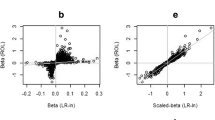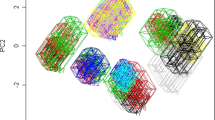Abstract
In some diseases it is well-known that a unimodal mortality pattern exists. A clear example in developed countries is breast cancer, where mortality increased sharply until the nineties and then decreased. This clear unimodal pattern is not necessarily applicable to all regions within a country. In this paper, we develop statistical tools to check if the unimodality pattern persists within regions using order restricted inference. Break points as well as confidence intervals are also provided. In addition, a new test for checking monotonicity against unimodality is derived allowing to discriminate between a simple increasing pattern and an up-then-down response pattern. A comparison with the widely used joinpoint regression technique under unimodality is provided. We show that the joinpoint technique could fail when the underlying function is not piecewise linear. Results will be illustrated using age-specific breast cancer mortality data from Spain in the period 1975–2005.

Similar content being viewed by others
References
Andersson E, Bock D, Frisén M (2004) Detection of truning points in business cycles. J Bus Cycle Meas Anal 1:93–108
Anraku K (1999) An information criterion for parameters under a simple order restriction. Biometrika 86:141–152
Akaike H (1973) Information theory and the extension of the maximum likelihood principle. In: Petrov BN, Csaki F (eds) Proceedings of the second international symposium on information theory. Akademiai Kiado, Budapest, pp 267–281
Bachettti P (1989) Additive isotonic models. J Am Stat Assoc 84:289–294
Banerjee M, Mukherjee D, Mishra S (2009) Semiparametric binary regression models under shape constraints with an application to Indian schooling data. J Econom 149:101–117
Bartholomew DJ (1961) A test of homogeneity for means under restricted alternatives. J R Stat Soc Ser B 23:239–281
Basso D, Salmaso L (2011) A permutation test for umbrella alternatives. Stat Comput 21:45–54 (correction: 2001;20:655)
Berrino F, De Angelis R, Sant M, Rosso S, Lasota MB, Coebergh JW et al (2007) Survival for eight major cancers and all cancers combined for European adults diagnosed in 1995–99: results of the EUROCARE-4 study. Lancet Oncol 8:773–783
Bock D, Andersson E, Frisén M (2008) Statistical surveillance of epidemics: peak detection of influenza in Swewden. Biom J 1:71–85
Brunk HD (1970) Estimation of isotonic regression (with discussion). In: Puri ML (ed) Nonparametric techniques in statistical inference. Cambridge University Press, Cambridge
De Souza DLB, Curado MP, Bernal MM et al (2013) Mortality trends and prediction of HPV-related cancers in Brazil. Eur J Cancer Prev 22:380–387
Dykstra R (1983) An algorithm for restricted least squares regression. Ann Stat 3:401–421
Feder PI (1975) On asymptotic distribution theory in segmented regression problems: identified case. Ann Stat 3:76–83
Gunn LH, Dunson DB (2005) A transformation approach for incorporating monotone or unimodal constraints. Biostatistics 6:434–449
Hastie T, Tibshirani R (1986) Generalized additive models. Stat Sci 3:297–310
Huang J (2002) A note on estimating a partly linear model under monotonicity constraints. J Stat Plan Inference 107:345–351
Hudson D (1966) Fitting segmented curves whose join points have to be estimated. J Am Stat Assoc 61:1097–1129
Hu X, Wright FT (1994) Likelihood ratio tests for a class of non-oblique hypotheses. Ann Inst Stat Math 46(1):137–145
Hur C, Miller M, Kong CY et al (2013) Trends in esophageal adenocarcinoma incidence and mortality. Cancer 119(6):1149–1158
Hwang JG, Peddada SD (1994) Confidence interval estimation subject to order restrictions. Ann Stat 22:67–93
Iverson GJ, Harp SA (1987) A conditional likelihood ratio test for order restrictions in exponential families. Math Soc Sci 14:141–159
Kato K (2009) On the degrees of freedom in shrinkage estimation. J Multivar Anal 100:1338–1352
Kim HJ, Fay MP, Feuer EJ, Midthune DN (2000) Permutation tests for joinpoint regression with applications to cancer rates. Stat Med 19:335–351 (correction: 2001, 20,655)
Köllmann C, Bornkamp B, Ickstadt K (2012) Unimodal regression using Bernstein-Schoenberg-splines and penalties. Technical Report. Universiy of Dortmund
Lagarde A, Beausoleil C, Belcher SM, Belzunces LP, Emond C, Guerbet M, Rousselle C (2015) Non-monotonic dose-response relationships and endocrine disruptors: a qualitative method of assessment. Environ Health. doi:10.1186/1476-069X-14-13
Lerman PM (1980) Fitting segmented regression models by grid search. Appl Stat 29:77–84
Lim C, Shen PK, Peddada SD (2013) Robust analysis of high throughput screening (HTS) assay data. Tecnometrics 55:150–160. doi:10.1080/00401706.2012.749166
Liu T, Lin N, Shi N, Zhang B (2009) Information criterion-based clustering with order-restricted candidate profiles in short time-course microarray experiments. BMC Bioinform 10:146. doi:10.1186/1471-2105-10-146
López-Campos JL, Ruiz-Ramos M, Soriano JB (2013) COPD mortality rates in Andalusia, Spain, 1975–2010: a joinpoint regression analysis. Int J Tuberc Lung Dis 17:131–136
Malvezzi M, Bertuccio P, Levi F, La Vecchia C, Negri E (2012) European cancer mortality predictions for the year 2012. Ann Oncol 23:1044–1052
Menéndez JA, Salvador B (1991) Anomalies of the likelihood ratio test for testing restricted hypotheses. Ann Stat 19:889–898
Menéndez JA, Rueda C, Salvador B (1991) Conditional test for testing a face of the tree order cone. Commun Stat Simul Comput 20(2&3):751–762
Menéndez JA, Rueda C, Salvador B (1992) Dominance of likelihood ratio tests under cone constraints. Ann Stat 20:2087–2099
Meyer M (2008) Inference using shape-restricted regression splines. Ann Stat 2:1013–1033
Meyer M, Woodruff M (2000) On the degrees of freedom in shape-restricted regression. Ann Stat 28:1083–1104
Molodecky NA, Soon IS, Rabi DM et al (2012) Increasing incidence and prevalence of the inflammatory bowel diseases with time, based on systematic review. Gastroenterology 142:46–54
Morton-Jones T, Diggle P, Parker L, Dickinson HO, Binks K (2000) Additive isotonic regression models in epidemiology. Stat Med 9:849–859
Muggeo VMR (2003) Estimating regression models with unknown break-points. Stat Med 22:3055–3071
Muggeo VMR (2008) Segmented: an R package to fit regression models with broken-line relationships. R News 8(1):20–25. URL http://cran.r-project.org/doc/Rnews/
O’Connell RG, Dockree PM, Kelly SP (2012) A supramodal accumulation-to-bound signal that determines perceptual decisions in humans. Nat Neurosci 15:1729–1735
Pan G (1997) Confidence subset containing the unknown peaks of an umbrella ordering. J Am Stat Assoc 92(437):307–314
Peddada SD (1997) Confidence interval estimation of population means subject to order restrictions using resampling procedures. Stat Probab Lett 31:255–265
Robertson T, Wright FT, Dykstra RL (1988) Order restricted statistical inference. Wiley, New york
Rueda C, Lombardía MJ (2012) Small area semiparametric additive monotone models. Stat Model 12:527–549
Rueda C (2013) Degrees of freedom and model selection in semiparametric additive monotone regression. J Multivar Anal 117:88–99
Ruiz-Medina MD, Espejo RM, Ugarte MD, Militino AF (2014) Functional time series analysis of spatio-temporal epidemiological data. Stoch Environ Res Risk Assess 28:943–954. doi:10.1007/s00477-013-0794-y
Shapiro A (1988) Towards a unified theory of inequality constraints testing in multivariate analysis. Int Stat Rev 56:49–62
Shi NZ (1988) A test of homogeneity for umbrella alternatives and tables of the level probabilities. Commun Stat Theory Methods 17:657–670
Shively TS, Walker SG, Damien P (2011) Nonparametric function estimation subject to monotonicity, convexity, and other shape constraints. J Econom 161:166–181
Simard EP, Ward EM, Siegel R et al (2012) Cancers with increasing incidence trends in the United States: 1999 through 2000. CA: Cancer J Clin 62:118–128
Sprent P (1961) Some hypotheses concerning two-phase regression lines. Biometrics 17:634–645
Statistical Research and Applications Branch, National Cancer Institute (2013). Joinpoint Regression Program, Version 4.0.4 - May 2013
Strand M, Zhang Y, Swihart B (2010) Monotone nonparametric regression and confidence intervals. Commun Stat Simul Comput 39(4):828–845
Susko E (2013) Likelihood ratio tests with boundary constraints using data-dependent degrees of freedom. Biometrika 100:1019–1023
Thomas SC (2010) Photosynthetic capacity peaks at intermediate size in temperate deciduous trees. Tree Physiol 30:555–573
Turner R (2013) Iso: functions to perform isotonic regression. R package version 0.0-12. http://CRAN.R-project.org/package=Iso
Turner TR, Wollan PC (1997) Locating a maximum usin isotonic regression. Comput Stat Data Anal 25:305–320
Ugarte MD, Goicoa T, Etxeberria J, Militino AF, Pollán M (2010) Age-specific spatio-temporal patterns of female breast cancer mortality in Spain (1975–2005). Ann of Epidemiol 20:906–916
Vandenberg LN, Colborn T, Hayes TB, Heindel JJ, Jacobs DR Jr, Lee DH, Shioda T, Soto AM, vom Saal FS, Welshons WV, Zoeller RT, Myers JP (2012) Hormones and endocrine-disrupting chemicals: low-dose effects and nonmonotonic dose responses. Endocr Rev 33:378–455
Wolfe DA (2006) Nonparametric distribution-free procedures for order restricted alternatives. In: Ahsanullah M, Raquad MZ (eds) Recent developments in order random variables. Nova Science, New York
Wollan PC, Dykstra RL (1986) Conditional test with an order restriction as a null hypothesis in advances in order restricted statistical inference. Lect Notes Stat 37:279–295
Zhao L, Peng L (2002) Model selection under order restrictions. Stat Probab Lett 57:301–306
Acknowledgments
This work has been supported by the Spanish Ministry of Science and Innovation (project MTM 2011-22664 jointly sponsored with Feder grants, project MTM 2012-37129 and project MTM2014-51992-R). The work has been also partially supported by the Health Department of Navarre Government (Project 113, Res. 2186/2014).
Author information
Authors and Affiliations
Corresponding author
Appendix
Appendix
The mathematical tools for understanding the proofs included in this appendix are not basic. For those readers who are not expert, we recommend first to read carefully the classical book by Robertson et al. (1988). New notation is also used to simplify the proofs. Let us define U as the union of cones \(U_q\) such that \(U=\cup _{q=t_1}^{t_n}U_{q}\), where \(U_q=\{{\mathbf{r}}\in {\mathfrak{R}}^{n} | \, r_{t_1}\le \cdots \le r_{q} \ge r_{q+1}\ge \cdots \ge r_{t_n}\}\). Then, the testing problems (1) and (2) can be reformulated as follows
where \(M_{q}=M \cap U_{q}\). \(R_{d}\) is referred as the set \(D=d\). The estimators \({\widehat{\mathbf{r}}}^{1q}\) and \({\widehat{\mathbf{r}}}^{0q}\) are given by the weighted projection of \({\mathbf{v}}\) with weights \(W=\text{ diag }(w_{t_1},\ldots ,w_{t_n})\) in the convex cones \(U_{q}\) and \(M_{q}\), defined as \(P_{W}(\mathbf{v}|U_{q})\) and \(P_{W}(\mathbf{v}|M_{q})\) respectively [see Robertson et al. (1988)]. In order to simplify notation the weight matrix is eliminated from the projection operator in what follows.
Lemma 1 shows that the cones defining the null and the alternative hypotheses in (11) verify a non oblique property. Then, Lemma 1 is used in the proof of Theorem 3.
Lemma 1
-
(i)
Let \(L_{U}\) and \(L_{M}\) be subsets verifying \(P({\mathbf{v}}|U_q)=P({\mathbf{v}}|L_{U}), P(P({\mathbf{v}}|U_q)|M_q)=P({\mathbf{v}}|L_{M})\). Then, \(L_{M} \subset L_{U}\)
-
(ii)
The regions \(M_q=M\cap U_q\) and \(U_q\) are non oblique
$$P(P({\mathbf{v}}|U_q)|M_q)=P({\mathbf{v}}|M_q ).$$
1.1 Proof of Lemma 1
-
(i)
\(L_{U}\) and \(L_{M}\) can be defined by a set of linear inequalities as follows: \(\ L_{M}=\left\{ {\mathbf{v}}\in {\mathbb{R}}^{n} |v_{i}=v_{i+1}, i \in B \right\}\) and \(\L _{U}=\left\{{\mathbf{v}}\in {\mathbb{R}}^{n} /v_{i}=v_{i+1}, i \in A \right\}\), where \(B, A \subset \{1,\ldots ,n-1\}\). The results will follow by showing that \(A \subset B\). Let \(i \in A\), then \(P(\mathbf{v}|U_q)_{i}=P(\mathbf{v}|U_q)_{i+1}\). Now, as the cone \(M_q\) is an acute cone we have that \(P(P({\mathbf{v}}|U_q)|M_q)_{i}=P(P({\mathbf{v}}|U_q)|M_q)_{i+1}\) [see Menéndez and Salvador (1991)] and the result follows.
-
(ii)
Let \(L_{U}\) and \(L_{M}\) be subspaces verifying \(P({\mathbf{v}}|U_q)=P({\mathbf{v}}|L_{U}), P(P({\mathbf{v}}|U_q)|M_q)=P({\mathbf{v}}|L_{M})\). Then, from basic properties of projections onto subspaces and convex cones, we have that for a given \({\mathbf{v}}\)
$${\mathbf{v}}=P({\mathbf{v}}|U_q)+P({\mathbf{v}}|{U_q}^{p})=P({\mathbf{v}}|U_q|M_q)+P({\mathbf{v}}|U_q|{M_q}^{p})+P({\mathbf{v}}|{U_q}^{p}),$$from (i) we have that \(L_{U}\subset L_{M}\), and then,
$${\mathbf{v}}=p({\mathbf{v}}|L_{U})+P({\mathbf{v}}|L_{U}^{\bot })=P({\mathbf{v}}|L_{M})+P({\mathbf{v}}|L_{M}^{\bot }\cap L_{U})+P({\mathbf{v}}|L_{U}^{\bot }).$$Now, as \(M_q\subset U_q\), and both are closed convex cones, then \({U_q}^{p}\subset {M_q}^{p}\) and
$$P({\mathbf{v}}|U_q|{M_q}^{p})+P({\mathbf{v}}|{U_q}^{p})=P({\mathbf{v}}|L_{M}^{\bot }\cap L_{U})+P({\mathbf{v}}|L_{U}^{\bot })\epsilon M_q^{p}.$$We also have that
$$P({\mathbf{v}}|U_q|M_q)=P({\mathbf{v}}|L_{M})\epsilon M_q,$$and
$$<P({\mathbf{v}}|L_{M}),P({\mathbf{v}}|L_{M}^{\bot }\cap L_{U})+P({\mathbf{v}}|L_{U}^{\bot })>\le 0.$$Then, from statements above and basic properties of projections onto convex cones, we have that
$$P({\mathbf{v}}|L_{M})=P({\mathbf{v}}|M_q).$$(12)Now, for \({\mathbf{v}} \in {\mathfrak{R}}^{n}\) and \(L_U\) and \(L_M\) subspaces as in (i), we have that
$$P(P({\mathbf{v}}|U_q)|M_q)=P({\mathbf{v}}|L_{M})=P({\mathbf{v}}|M_q)$$and this last statement shows that \(M_q\) and \(U_q\) are non-oblique. \(\square\)
1.2 Proof of Theorem 3
-
(i)
From Lemma 1 (ii), Lemma 2.2. in Menéndez et al. (1992), and basic properties of polar cones, \(T_{0q}\) is given by
$$T_{0q}=\Vert P({\mathbf{v}}|U_q\cap {M_q}^{p})\Vert ^{2}=\Vert P({\mathbf{v}}|U_q\cap {M}^{p})\Vert ^{2}.$$(13)Let \(R_{d}\) be given by \(R_{d}=\{{\mathbf{v}} \in {\mathfrak{R}}^{n}|P({\mathbf{v}}|U_q\cap {M}^{p})=P({{v}}|L), dim L=d\}\). From Lemma 1 is easy to prove that \(R_{d}=\{{\mathbf{v}} \in {\mathfrak{R}}^{n}|P({\mathbf{v}}|U_q)=P({\mathbf{v}}|L_{U}),P({\mathbf{v}}|M_q)=P({\mathbf{v}}|L_{M}),d=dim(L_{U})-dim(L_{M})\}\). Now Shapiro (1988) shows that, for \({\mathbf{r}}_0\), the conditional distribution of \(T_{0q}\) given to the subsets \(R_{d}\) is a chi-squared with d degrees of freedom and the result follows.
-
(ii)
From (i) and equality
$$R_{0}=\{{\mathbf{v}} \in {\mathfrak{R}}^{n}|P({\mathbf{v}}|U_q)=P({\mathbf{v}}|M_q)\}=\{{\mathbf{v}} \in {\mathfrak{R}}^{n}/ T_{0q}({\mathbf{v}})=0\},$$we have that
$$\begin{aligned} \Pi _q({\mathbf{r}}_0)&=\sum _{d}pr_{r_{0}}\left( T_{0q}\ge c(d)\right| {\mathbf{v}} \in R_{d})pr_{r_{0}}( {\mathbf{v}} \in R_{d})\\&=\sum _{d}pr\left( \chi ^2_{d}>c(d) \right) pr_{r_{0}}( {\mathbf{v}} \in R_{d}) \\&=\frac{\alpha }{1-pr_{r_{0}}(T_{0q}=0)} \sum _{d}pr_{r_{0}}( {\mathbf{v}} \in R_{d}) \\&=\frac{\alpha }{1-pr_{r_{0}}(T_{0q}=0)}(1-pr_{r_{0}}({\mathbf{v}} \in R_{0}))=\alpha \end{aligned}$$and the results follow.\(\square\)
Rights and permissions
About this article
Cite this article
Rueda, C., Ugarte, M.D. & Militino, A.F. Checking unimodality using isotonic regression: an application to breast cancer mortality rates. Stoch Environ Res Risk Assess 30, 1277–1288 (2016). https://doi.org/10.1007/s00477-015-1111-8
Published:
Issue Date:
DOI: https://doi.org/10.1007/s00477-015-1111-8




